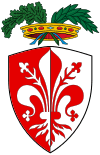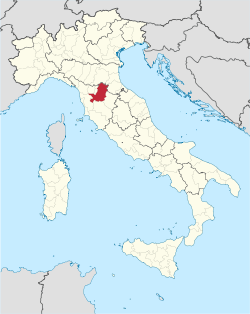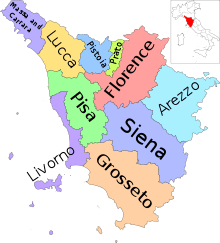Metropolitan City of Florence
The Metropolitan City of Florence (Italian: Città Metropolitana di Firenze) is a metropolitan city in the Tuscany region, Italy. Its capital is the city of Florence. It replaced the Province of Florence. It was first created by the reform of local authorities (Law 142/1990) and then established by the Law 56/2014. It has been operative since January 1, 2015.
Metropolitan City of Florence | |
|---|---|
Metropolitan City | |
Palazzo Medici Riccardi, the seat of the metropolitan city | |
 Coat of arms | |
 Map highlighting the location of the province of Florence in Italy | |
| Country | |
| Region | Tuscany |
| Created | 1 January 2015 |
| Capital(s) | Florence |
| Comuni | 44 |
| Government | |
| • Metropolitan Mayor | Dario Nardella (PD) |
| Area | |
| • Total | 3,514 km2 (1,357 sq mi) |
| Population (30 June 2015) | |
| • Total | 1,012,388 |
| • Density | 290/km2 (750/sq mi) |
| Time zone | UTC+1 (CET) |
| • Summer (DST) | UTC+2 (CEST) |
| Postal code | n/a |
| Telephone prefix | n/a |
| Vehicle registration | FI |
| ISTAT | 248[1] |
| Website | www |
Geography
The Metropolitan City of Florence is bordered by the Metropolitan City of Bologna in the north, the province of Ravenna and Forlì-Cesena in the north-east, the province of Prato, Pistoia and Lucca in the north-west, the province of Pisa in the west, the province of Siena in the south and the province of Arezzo in the east and southeast.[2]
Much of its territory lies in the plain of the Arno river and has thus become an exurban sprawl around the city of Florence. The northeastern part of the metropolitan city, in the Apennines, remains less developed. Romagna Granducale is the name given to the region lying on the northern slopes of Apennines. Corn, wine and silk are the chief products in the valley regions. Silk manufacturing was an important industry in the medieval times.[3] The well known Renaissance artist Leonardo da Vinci was born in the village of Anchiano which is a part of the Metropolitan City of Florence.[4] The capital Florence is a well known cultural and a large tourist centre.[5]
Main sights
The Metropolitan City receives large number of tourists every year.
The capital city Florence has been recognised as UNESCO World Heritage Site. Major tourist attractions of the city are Piazza del Duomo, Duomo of Santa Maria del Fiore, the Baptistery of San Giovanni, Giotto's Bell Tower, the Loggia del Bigallo and Museo dell'Opera di Santa Maria del Fiore, Ponte Vecchio and many others.
Sights in Barberino di Mugello include Cattani Castle and Palazzo Pretorio. The Certosa del Galluzzo houses artworks by Pontormo. Giovanni Boccaccio's hometown Certaldo is home to the Palazzo Pretorio and Boccaccio’s House, while Vinci, birthplace of Leonardo da Vinci, houses a museum dedicated to the Italian polymath. Sesto Fiorentino is known for the Etruscan tomb “La Montagnola”.[6]
Government
List of Metropolitan Mayors of Florence
| Metropolitan Mayor | Term start | Term end | Party | |
|---|---|---|---|---|
| 1 | Dario Nardella | 1 January 2015 | Incumbent | Democratic Party |
Economy
Wholesale and retail is the largest sector in the Metropolitan City: As of 2008, almost 29% of the firms in the former Province of Florence were involved in it. Manufacturing, construction, real estate and agriculture are the next important ones with a percentage share of about 19.5%, 14%, 13.6% and 8% respectively.[7]
Tourism is also an important industry. Empoli is known for its ancient glass-making industry.[8]
References
- "Codici delle città metropolitane al 1° gennaio 2017". www.istat.it (in Italian). 23 December 2016.
- Domenico 2002, p. 314.
- Society for the diffusion of useful knowledge (1838). The penny cyclopædia [ed. by G. Long]. p. 319.
- Domenico 2002, p. 318.
- Domenico 2002, p. 315.
- "Florence, Tuscany". ITALIA. Retrieved 18 September 2014.
- Cooke & Schwartz 2008, p. 185.
- Domenico 2002, p. 324.
- Domenico, Roy Palmer (2002). The Regions of Italy: A Reference Guide to History and Culture. Greenwood Publishing Group. ISBN 978-0-313-30733-1.CS1 maint: ref=harv (link)
- Cooke, Philip; Schwartz, Dafna (2008). Creative Regions: Technology, Culture and Knowledge Entrepreneurship. Routledge. ISBN 978-1-134-07865-3.CS1 maint: ref=harv (link)
External links

